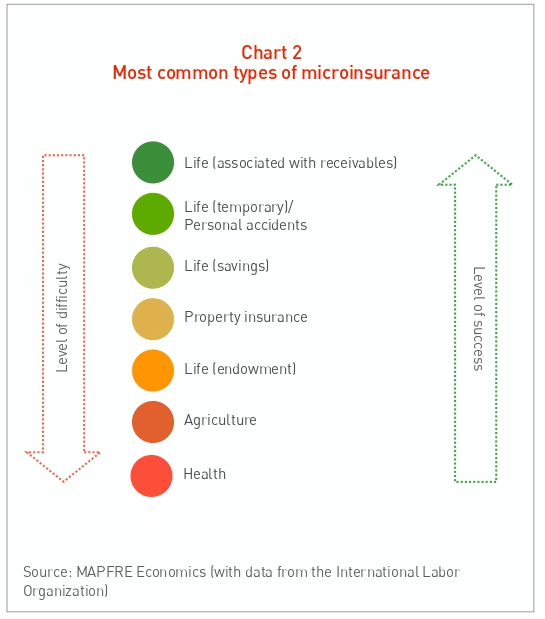Financial Inclusion in Insurance
Author: MAPFRE Economics
Summary of the report’s conclusions:
MAPFRE Economics
Financial Inclusion in Insurance
Madrid, Fundación MAPFRE, June 2020
The concept known as financial inclusion is the process through which a society provides access to different financial services (credit, savings, insurance, payment and pension services), as well as financial education mechanisms, with the goal of improving its material well-being. In the case of insurance activity, financial inclusion focuses on allowing excluded or underserved groups, usually lower-income groups, to gain access to the products that enable them to protect their life, health and assets, through the loss compensation and savings processes which are an inherent part of insurance products (see Chart 1).

As such, “microinsurance” is a tool that can be used to protect the most economically vulnerable populations, small businesses, farmers, stockbreeders, and companies from unexpected costs due to the occurrence of an event which can be mutualized through insurance techniques.
Two main factors can be identified that are influencing the development of activities aimed at enhancing inclusive insurance and, in particular, microinsurance at the global level in recent years. The first is the willingness of international bodies and public authorities to stimulate its growth to support vulnerable groups, as part of the design of public policies aimed at promoting the social factor in business activity. The second is technology, which can facilitate access to a broad group of prospective policyholders (even in rural areas) at a reasonable cost.
The role of technology
From a technological standpoint, there are several elements that may influence the future development of microinsurance. Among them are the following:
- Electronic payment methods (especially for unbanked populations).
- Digital platforms (through a website or mobile apps).
- Electronic identification, the Internet of Things (IoT), sensors (wearables, telemetry).
- Information obtained through artificial satellites and social networks.
- Cloud services (data storage and computing).
- Macro data analytics, artificial intelligence and machine learning (chatbots, call center management, pricing calculation, among other applications).
- Video calls (especially for health insurance).
- Blockchain, still at an early stage (electronic contracts, etc.).
The lack of information on insurance policyholders has been identified as one of the major issues when it comes to issuing microinsurance policies. Therefore, these technological elements may be extremely useful when segmenting clients according to the data they provide, with a view to preventing the absence of such data from resulting in surcharges which can significantly raise the price of products. In addition, such technologies facilitate the digital identification of policyholders; the receipt, management and payment of claims (including automatic compensation based on indices); the analysis of call center calls, chatbots, and information from social networks; the detection of fraud; as well as the prevention and mitigation of risks, etc.
Electronic money and payment methods are of particular relevance to the development of microinsurance. The ability to write policies for these types of products via prepaid cell phones is a significant phenomenon that is serving to increase the penetration of microinsurance in regions such as Africa, Latin America and emerging countries in Asia. Additionally, the digital platforms used for carrying out shipments and electronic sales can also contribute to the development of this type of product.
Most of the time, the most vulnerable groups are found in rural areas, which makes access to traditional insurance distribution channels difficult, as these tend to focus on urban areas due to cost efficiency. However, new digital distribution channels are helping to break down this barrier.
Chart 2 shows the classification of the most common microinsurance products according to their relative marketing success, which is inversely related to the level of difficulty in their implementation.

As can be seen, the most common microinsurance product on the market is life insurance associated with receivables (also known as credit life insurance). This is essentially because of the partnerships that have been forged between insurance companies and companies specialized in granting microloans in emerging countries, known as “microfinance institutions” or “Monetary Financial Institutions (MFIs).” However, in recent years there has been a great deal of innovation. Digital native insurance companies have emerged that have developed platforms that enable them to market microinsurance in most emerging countries, and with a wide variety of products. This includes more complex products that allow medical consultations to be conducted via video call and medication to be prescribed remotely, for example.
Development potential in the field of financial inclusion
The greatest potential within “microinsurance” lies in its targeting of the low-income population in the informal economy, which in emerging countries is often regarded as a target group for “microinsurance” programs. This is because the low-income segment that provides its services under the egis of formal labor contracts usually has accident, disability and death coverage as part of its mandatory remuneration package. Chart 3 shows the countries with the greatest potential for development in the field of financial inclusion, sorted by income level.

The comparative analysis of the microinsurance activities being carried out in several emerging countries in Asia, Mexico, Central America, Colombia, Brazil, Peru, Argentina and other Latin American markets can be found in the MAPFRE Economics report “Financial inclusion in insurance,” available at the following link:




